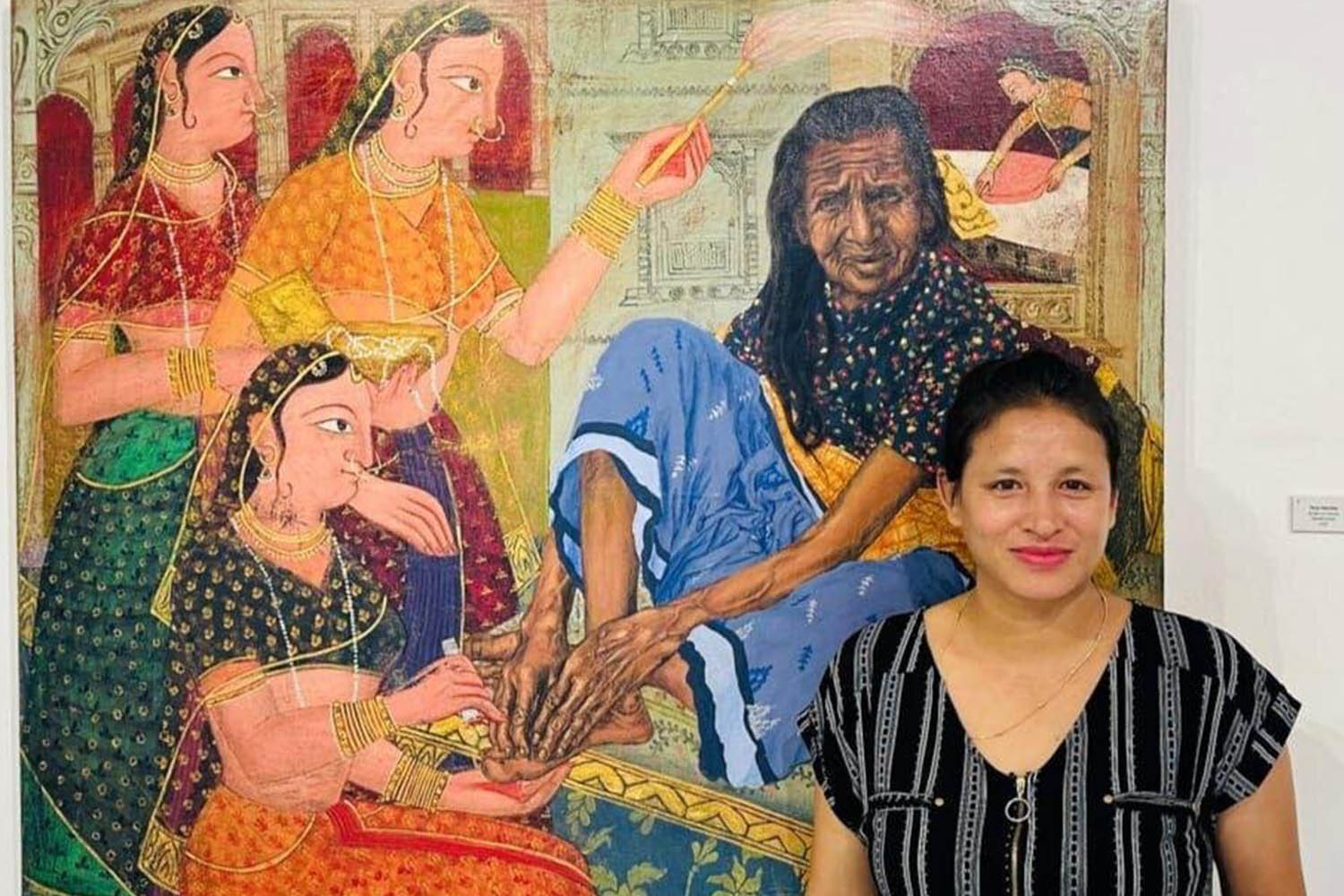Arts
Evolving roles, generational divides and deferred dreams
Muna Bhadel’s work pays tribute to her grandmother’s life and highlights the societal barriers that have restricted women’s opportunities in Nepal.
Isabel Irwin
In a world shaped by technological advancements and shifting societal norms, traditional roles of women as primary caretakers have undergone significant transformation. This shift is vividly captured in Muna Bhadel's artistic practice, whose paintings reflect her grandmother’s life and the broader implications for women in Nepal.
Early marriages and familial responsibilities profoundly influenced many older female generations, including Bhadel’s grandmother. Bhadel’s artistic practice delves into her grandmother's life experiences and dreams, offering personal insight into the generational differences between older women and their younger counterparts.
With her exhibition, ‘Silent Whispers’, which opened at Siddhartha Art Gallery on August 19, she hopes that young Nepali women who view her work can relate to and connect to her experiences.
Bhadel shared that her grandmother was eight years old when she married her husband, who was 13. This left her grandmother with many unfulfilled dreams and repressed desires, which her granddaughter has had the chance to pursue. Her artwork, supported by an Australian Himalayan Foundation Art Award, seeks to bring this generational divide to light in a way that resonates with contemporary Nepali women.
Bhadel’s recent work consists of large acrylic paintings featuring elderly Nepali women, often based on her grandmother. These paintings are distinctive due to her use of two different painting styles, which signify the separation between her grandmother and her dreams. While her grandmother is depicted in a hyper-realistic style, the rest of the scenes are in a pictorial style inspired by old Nepali and Indian Mughal/Rajput miniature paintings.
In addition, the artist intentionally chooses the colours and patterns worn by the women in her paintings, adding another dimension to the meanings behind her paintings. Traditionally, clothing changes depending on a woman’s marital status, meaning that clothing can signify what stage of life a woman is in. For example, as the artist explained, when a woman is married, she usually wears red, but when she is widowed, she must wear white. In most of her paintings, her colour palette is predominantly red.

One of her paintings particularly stood out to me. It features her grandmother looking downwards, longingly, out of a traditional Nepali window frame. To her right are three vertical scenes of lovers, reminiscent of a Patachitra narrative scroll.
The first scene features Krishna attending to Radha’s hair, the second is a man bowing to his lover, and the third is two lovers sharing a meaningful conversation. Bhadel described these scenes as the love and intimacy that her grandmother wished she had felt from her husband and the life she wished she had had the opportunity to pursue.
The painting evokes a strong sense of grief, grief over a life that never happened and experiences that were taken away before Bhadel’s grandmother was old enough to make her own decisions.
In an interview, Bhadel reflected on how, just two generations later, she has experienced many freedoms that her grandmother had not—falling in love and pursuing her artistic career.
The artist’s work not only honours her grandmother's journey but also serves as a broader commentary on the societal constraints that have historically limited women’s opportunities in Nepal.
Early marriages restrict young girls from pursuing their education and realising their full potential. Child marriage was officially made illegal in Nepal in 1963, and the nation has one of the highest legal ages for marriage at 20 years old (or 18 with parental consent). Unfortunately, statistics reveal a mixed picture: while there has been progress in reducing child marriage rates, substantial barriers remain, particularly in rural areas where the law is harder to implement.
Various women’s rights activist groups have pushed for stricter laws on child marriage and more focus on women’s education, resulting in the Nepal Government endorsing a National Strategy to End Child Marriage in Nepal by 2030 in 2016.
This governmental promise is incredibly important, as a lack of autonomy over one’s body restricts freedoms in nearly every aspect of life. According to a UN study conducted in Nepal in 2016, only 47.7 percent of women aged 15-49 said that they make their own decisions regarding sexual relations, contraceptive use, and reproductive healthcare.
In partial correlation with the dropping child marriage rates, girls’ access to education has greatly increased, which is another major contributor to the generational divide that Bhadel has experienced.
A study conducted in 2018 by UNESCO showed that the literacy rate of women aged 15-24 was 90.88 percent, while the literacy rate of all women ages 15+ was only 59.72 percent. This reveals a huge difference in the number of women in the new generation who have had access to schooling and have the opportunity to pursue their dreams beyond building a family.

Her paintings vividly depict the unrealised dreams of women who have navigated the complexities of familial responsibilities. The contrast between realistic portrayals and imaginative Mughal-style scenes underscores the tension between personal aspirations and societal expectations. These artworks testify to the resilience and untold stories of women whose voices are often marginalised.
Through her art, Bhadel emphasises the importance of understanding and learning from the older female generation’s experiences rather than simply highlighting feminist struggles. Her art memorialises personal histories rather than advocating for an avenue for societal change.
With her paintings, she hopes to foster a deeper understanding among her audience, particularly younger women grappling with similar societal pressures. Bhadel’s relationship with her grandmother reflects a broader societal phenomenon, so she hopes that when Nepali women see her artworks, they can reflect on their own experiences with their female relatives’ generation gap.
‘Silent Whispers’
Where: Siddhartha Art Gallery, Baber Mahal Revisited, Kathmandu
Timings: 11:00 am to 5:00 pm, On Saturday: 12:00 pm to 5:00 pm
Till September 18
Irwin is a Cypriot undergraduate student studying anthropology alongside visual arts at Princeton University.




 18.37°C Kathmandu
18.37°C Kathmandu










